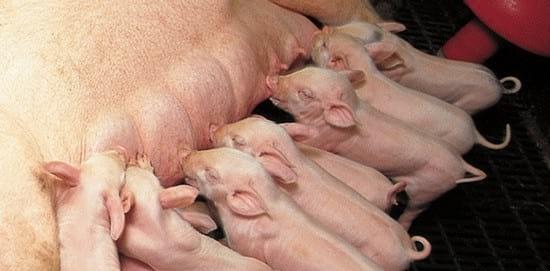Stalosan reduces mortality significantly in the farrowing unit
Published: December 13, 2016
By: By Group R&D Director Hans Aae, DLG
The newborn piglet is challenged in many ways. It has to keep warm, find food and keep bacteria away. These particular challenges are the reason why piglets are not surviving or getting off to a bad start.
Stalosan F dries the piglet and reduces the harmful bacteria and therefore a strategic use around birth is worth trying.
The skin as barrier
Stalosan F has a pH level around 4 corresponding to the pH level of the skin. It means that if you choose to use Stalosan F for drying the skin is not damaged unlike drying with a product with a high pH. If the pH level is too high the skin is damaged and there is a risk that ”the barrier” is destroyed.
Why take the risk?
Why take the risk?
The drying is causing that the piglets are not using energy on this part, but they can use all gained energy from the colostrum to grow. This makes sense - especially for the smallest piglets.
All or nothing – or strategic choice
In terms of resources it can be difficult for the staff members in the farrowing units to dip all newborn pigs in Stalosan F in order to dry them. At 50 farrowings it quickly can amount to 1,000 piglets. If you choose to focus on the smallest piglets facing the largest challenges, then it might amount to 200 piglets – and perhaps this makes more sense and a more manageable task.
If you place a bucket with Stalosan F at each farrowing pen it is easy to ”dry” some piglets as you pass by. It is a question of routines – in the same way as you turn on the heating lamp the bucket with Stalosan F should be ready at each pen. If diarrhoea problems appear in the farrowing pen or if there are moist areas, then the surplus Stalosan F can be used to reduce the infection pressure at the same time.
Works in practice
At Vilofoss Research Farm in France we have tested drying with Stalosan F against a competitor’s product and against piglets having no intervening. The tests show that Stalosan F reduces the mortality in the farrowing unit significantly compared to no intervening and the competitor’s product.
The effect can be a result of less chilled piglets or reduced disease pressure, but in any case more piglets are weaned – and that is the most important thing.

The effect can be a result of less chilled piglets or reduced disease pressure, but in any case more piglets are weaned – and that is the most important thing.

Stalosan F has a desiccating effect and controls bacteria, fungi, viruses, parasites, ammonia and moisture effectively. Absorbs and binds moisture and ammonia. Unlike most other hygiene agents Stalosan F has a low pH value supporting the natural disease resistance of the animals. Stalosan F has nearly 100% disinfectant effect towards PRRSv. Stalosan F reduces the population of flies.
Related topics:
Authors:
Vilofoss
Recommend
Comment
Share
22 de marzo de 2017
Mr. A. Tugbiyele I'm a user of Stalosan f on my farm, I use it with the fan at the doses recommended by the firm:
Dosage instructions with blower
The F Stalosan recommended dose is 50 g / m2 (one pound per 100 sq. Feet)
Blowing
During the blowing of Stalosan F, all ventilation systems Should be switched off. (If the area is 100 m2, for instance, 5 kg Stalosan F Should be used).
Weigh the amount of Stalosan F required in a bucket. (However, a maximum of 5 kg Stalosan F is recommended for blowing each session two to the blower's range.)
Position yourself Securely, holding the machine in your left or right hand. (The blower is designed for one-handed operation).
Place the blower with the suction pipe in the bucket containing Stalosan F. Do not completely cover the mouth of the pipe with Stalosan F.
During the blowing of Stalosan F, point the blower exhaust up (at 15 ° - 45 ° angle off the ground) and move it from side to side. (This method maximises the dispersion and distribution of Stalosan F. Dispersion experiments indicated That the Stalosan F blowing range is about 100 m2from a single position. The blowing takes 1-1½ minutes. Normally the blower can spread up to 8 kg per minute Stalosan F .)
If the animal housing area is larger than 100 m2, divided up the area and select multiple locations blowing. (For instance, a surface area of ??500 m2 requires 5 Placed strategically blowing points.)
To maintain the desired effect, blow out Stalosan once a week.
After blowing, run the blower until it has blown out all the Stalosan F contents.
I hope this helps and good luck
Recommend
Reply
Recommend
Reply

Would you like to discuss another topic? Create a new post to engage with experts in the community.










